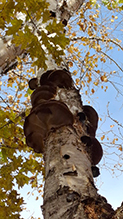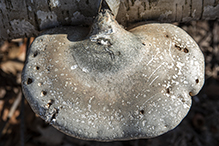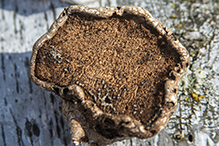Birch Polypore
(Fomitopsis betulina)
Conservation • Description • Habitat • Ecology • Use • Distribution • Taxonomy
Conservation Status |
|||
| IUCN Red List | not listed |
||
| NatureServe | NNR - Unranked |
||
| Minnesota | not listed |
||
Description
Birch Polypore is a very common, easily recognized bracket fungus. It occurs in Europe, Asia, and North America. In the United States it occurs from Maine to North Carolina, west to Kansas, and in the northwest. It is very common in the woodlands of eastern Minnesota. It grows alone, in groups, or in columns exclusively on birch, usually on dead trees and logs, sometimes on living trees. It obtains its nutrients from dead wood (saprobic). It also attacks weakened live trees, killing them and then feeding on the dead wood (necrotrophic). It is annual but the cap persists through the winter.
The cap is kidney-shaped to almost round in outline, 2″ to 10″ (5 to 25 cm) wide, and ¾″ to 2⅜″ (2 to 6 cm) thick. It is white, smooth, and hairless when young. The upper surface is covered with a thin skin. As it ages, the skin becomes pale grayish-brown, cracks, and often breaks away in small patches. The margin is thick, rounded, and rolled under, creating a “curb” around the pore surface on the underside.
The pore surface is white at first, turning yellowish-brown as it ages. It is recessed, with the curb-like margin extending below it. The pores are small, with 2 to 4 pores per millimeter. The bracket is annual so there is only one layer of pores.
There is often no stalk. When present, the stalk is thick, up to 2⅜″ (6 cm) long, and attached to the side or top of the cap.
The flesh is white, thick, and corky. It is edible when young but it is tough and it may be bitter.
The spore print is white.
Similar Species
Habitat and Hosts
Deciduous woodlands.
Birch.
Ecology
Season
June through fall, but present year round
Use
Ötzi, the Tyrolean Ice Man who was frozen 5,000 years ago and thawed in 1991, carried two species of fungus with him: true tinder polypore and birch polypore. The former was part of a fire lighting kit, the latter was probably used for medicinal purposes.
Distribution |
||
|
Sources Biodiversity occurrence data published by: Minnesota Biodiversity Atlas (accessed through the Minnesota Biodiversity Atlas Portal, bellatlas.umn.edu, 10/29/2025). |
|
| 10/29/2025 | ||
Occurrence |
||
Very common in eastern Minnesota |
||
Taxonomy
Kingdom
Fungi (Fungi)
Subkingdom
Dikarya
Phylum
Basidiomycota (club fungi)
Subphylum
Agaricomycotina (jelly fungi, yeasts, and mushrooms)
Class
Agaricomycetes (mushrooms, bracket fungi, puffballs, and allies)
Subclass
incertae sedis (uncertain placement)
Order
Polyporales (shelf fungi)
Family
Fomitopsidaceae (bracket polypores)
Genus
Fomitopsis
Genus
This species was originally classified in 1788 as Boletus betulinus. In 1881 it was transferred to the genus Piptoporus. Based on molecular phylogenetic studies published in 2013 and 2016, it was transferred to the genus Fomitopsis in 2017.
Subordinate Taxa
Synonyms
Agarico-pulpa pseudoagaricon
Agaricum conchatum
Boletus betulinus
Boletus suberosus
Buglossoporus betulinus
Fomes betulinus
Piptoporus betulinus
Placodes betulinus
Polyporus betulinus
Suillus betulinus
Ungularia betulina
Ungulina betulina
Common Names
Birch Bracket
Birch Conk
Birch Polypore
Glossary
Polypore
A bracket fungi. A fungi that produces its spores in pores on the underside of a woody fruiting body (conk).
Saprobic
A term often used for saprotrophic fungi. Referring to fungi that obtain their nutrients from decayed organic matter.
Visitor Photos
Share your photo of this fungus.
This button not working for you?
Simply email us at info@MinnesotaSeasons.com.
Attach one or more photos and, if you like, a caption.
Luciearl |
||
 |
 |
|
Fungi on birch |
Fungi on birch |
|
 |
 |
|
Fungi on birch |
||
 |
 |
|
Nancy Falkum |
 |
Greg Watson |
 |
MinnesotaSeasons.com Photos
 |
 |
|
 |
 |
|
 |
 |
|
 |
 |

Slideshows

Visitor Videos
Share your video of this fungus.
This button not working for you?
Simply email us at info@MinnesotaSeasons.com.
Attach a video, a YouTube link, or a cloud storage link.
Other Videos
Birch Polypore — Mushroom Identification & Medicinal Benefits with Adam Haritan
Learn Your Land

Visitor Sightings
Report a sighting of this fungus.
This button not working for you?
Simply email us at info@MinnesotaSeasons.com.
Be sure to include a location.
MinnesotaSeasons.com Sightings |





